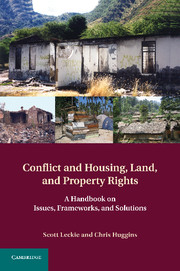Book contents
- Frontmatter
- Contents
- Opening Note and Acknowledgments
- Foreword by Dan Lewis
- 1 Introduction to the Issues – HLP Rights and Sustainable Peace
- 2 The International HLP Rights Normative Framework
- 3 Displacement, Conflict, and HLP Rights
- 4 HLP Restitution Rights
- 5 Restitution Mechanisms and Institutional Frameworks
- 6 United Nations and Other Peace Operations and HLP Rights
- 7 Protracted Displacement and Political Obstacles to the Protection of HLP Rights
- 8 Emerging Conceptual Issues
- 9 Improving International Responses to HLP Rights and Conflict
- Index
8 - Emerging Conceptual Issues
Published online by Cambridge University Press: 03 May 2011
- Frontmatter
- Contents
- Opening Note and Acknowledgments
- Foreword by Dan Lewis
- 1 Introduction to the Issues – HLP Rights and Sustainable Peace
- 2 The International HLP Rights Normative Framework
- 3 Displacement, Conflict, and HLP Rights
- 4 HLP Restitution Rights
- 5 Restitution Mechanisms and Institutional Frameworks
- 6 United Nations and Other Peace Operations and HLP Rights
- 7 Protracted Displacement and Political Obstacles to the Protection of HLP Rights
- 8 Emerging Conceptual Issues
- 9 Improving International Responses to HLP Rights and Conflict
- Index
Summary
PEACE AGREEMENTS AND HLP RIGHTS
In recent years, there has been greater recognition of the role of HLP issues in the genesis of violent conflict, as well as the risk of secondary disputes over HLP during the postconflict period. Accordingly, many recent peace agreements pay attention to aspects of HLP rights. In recognition of this, in his 2007 report on the protection of civilians in armed conflict, the UN Secretary-General recommended:
Restorative actions, such as the inclusion of the right to return and restitution of housing, land or property in all future peace agreements.
The HLP rights of returning refugees and IDPs are commonly addressed in peace agreements. Less often, institutional arrangements for improving land administration or resolving historical land disputes may be outlined. The trend is promising, but a review of postconflict HLP rights in a number of countries suggests that sustained commitment at both the national and international levels is necessary to translate the agreements into sustained and principled action on the ground. The nature of the several protracted conflicts around the world requiring resolution – Palestine/Israel, Darfur, Iraq, Burma, and others – all place HLP issues at the direct core of both the causes and results of these conflicts, as well as their eventual just and sustainable resolution.
Peace mediators often face a difficult choice between encouraging the parties to fully develop a comprehensive peace agreement in great detail, through lengthy discussions, and settling for a broad “framework” agreement that establishes institutions and processes through which the detailed plans will be formulated.
- Type
- Chapter
- Information
- Conflict and Housing, Land and Property RightsA Handbook on Issues, Frameworks and Solutions, pp. 221 - 247Publisher: Cambridge University PressPrint publication year: 2011

